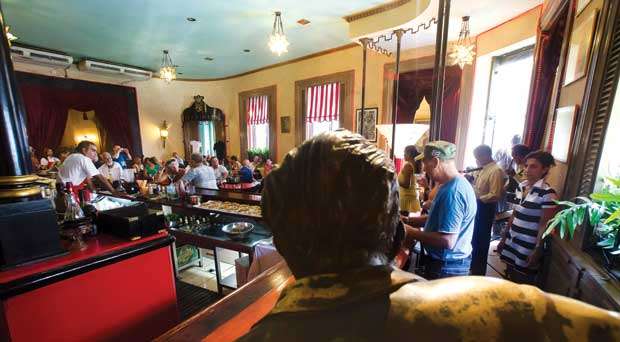As he leans on the dark, 118-year-old bar, the bronze Hemingway seems to looking sardonically at all of the pilgrims who enter Floridita bar and restaurant, drawn by the mysticism of the legendary “Papa.” They come from all over the world on the Hemingway trail, and an aspiring writer might hope to find his or her muse in the cocktail immortalized by the immortal adventurer: the daiquiri.
From the corner where sculptor José Villa Soberón placed him to observe the locale, the bronze figure seems to blend in with all the other regulars. One of these days, his tormented soul will be reincarnated out of an irrepressible desire to once again order his version of the daiquiri: no sugar or lemon, a dash of grapefruit juice and a double shot of rum, the personal medicine of a diabetic who lived fearlessly….
Floridita had existed for more than a century by the time Ernest Hemingway’s romance with the place was born. Behind the bar, Constantino Ribalaigua was holding court on that day in 1928 when the novelist came in looking for a bathroom. After attending to his needs, Hemingway decided to beat the heat and wet his whistle on his first visit to Havana. Constantino served him a daiquiri and “Papa’s” life was never the same again…. He liked it so much that in his novel Islands in the Stream, he wrote that the Floridita cocktail “couldn’t be better, not even close, anywhere else in the world.”
It was founded in 1817 as La Piña de Plata, on the corner where Obispo street ends coming from the port, and was subsequently called La Florida and then Floridita. While it is known internationally as “the birthplace of the daiquiri,” the cocktail’s name actually refers to a beach called Daiquiri in Santiago de Cuba. However, Constantino deserves the credit for the daiquiri as God meant for it to be: to the mixture of sugar, lemon and rum, he added a few drops of maraschino and frappé ice.
The fact that Hemingway adopted Floridita as his “office” undoubtedly contributed to its fame, but it was the bar’s own merits that made it a favorite among Havana’s bohemians and visiting celebrities, like Ava Gardner. In 1953 Esquire magazine listed it among the seven most famous bars in the world, and today it is one of the 10 best literary bars. In fact, the tourism review website TripAdvisor recently awarded Floridita its Certificate of Excellence.
With two Habanosommelier world champions on its staff, Floridita’s workers are efficient and capable of holding forth on “marriages” and cocktails without any fear of the growing competition, especially in the private sector. On the contrary, contests like “The King of the Daiquiri” are opening their doors to the new generations of bartenders to defend a cocktail that, together with the mojito and the Cuba Libre, is a standard drink all over the world.
Floridita serves 18 different daiquiris, and while every maestro has his or her secret, bartender Nicolay Mesa says the real trick is “making it a lot.” Like his fellow barmen, Nicolay mixes the ingredients almost by instinct and always has a steady hand. They know that they are being judged every day by their customers, by history, and by a certain person in bronze who knew how to do more than write. Hemingway knew how to drink, especially his daiquiri, and inevitably at Floridita.










